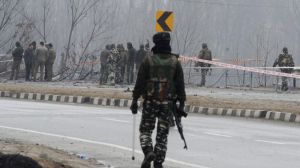Aloo bhujia the most ordered snack for New Year: Why this munchie is adding to your belly fat
Most Indians with sedentary lifestyle but mismatched eating habits like high-fat snacking are tipping their scales towards obesity
 A 100 gm pack of Aloo Bhujia from any brand has a range of 500 to 600 calories. (Representational Image)
A 100 gm pack of Aloo Bhujia from any brand has a range of 500 to 600 calories. (Representational Image)As Blinkit co-founder Albinder Dhindsa posted how aloo bhujia was the most preferred snack on New Year’s Eve, with 2,34,512 packages sold, it shows why Indians continue to eat wrong. This high calorie snack, munched in between meals, and in accompaniment with other finger foods or alcohol, causes an overload that the body cannot process. This is why calories get converted into fat, particularly around the belly.
Aloo bhujia has an addictive flavour profile. A 100 gm pack from any brand has a range of 500 to 600 calories, which is about 25 per cent of an adult’s calorie requirement.
CALORIE-DENSE VS NUTRIENT-DENSE
“What is worrisome is that most of the calories come from the saturated fat it is coated in. High fat snacks add more calories to the diet. Most Indians with sedentary lifestyle but mismatched eating habits like high-fat snacking are tipping their scales towards obesity,” says Dr R M Anjana, president, Madras Diabetes Research Foundation. Since they are made of potato, there are carbohydrates to worry about. Bhujia has refined sugar which is digested easily, spiking your blood sugar and making you hungrier sooner.
Aloo bhujia also contains higher sodium (salt content). “Regular consumption of snacks like aloo bhujia, which are high in calories, fat and salt can lead to water retention, cardio metabolic risks like blood pressure, high cholesterol and obesity-linked chronic diseases like diabetes and heart disease,” says Dr Anjana.
Eating in moderation is the key to developing healthy eating behaviour but given the addictive nature of aloo bhujia, nobody can stop at either a teaspoon or tablespoon of aloo bhujia once in a while. Besides, aloo bhujia is an easy carry-on sachet with extreme palatability of spices and crunch. “Since they are more calorie-dense than nutrient-dense, they make us feel full in the moment but aren’t heft enough to keep you satisfied. So you tend to be hungrier sooner than expected and end up eating more,” adds Dr Anjana.
NOT EASY TO BURN EXTRA CALORIES
The time it takes to burn 500 calories depends on the intensity of the activity. According to estimates by experts, you would need a 45-minute run to burn them. Or 90 minutes of brisk walking. Jogging for about 60 minutes burns 500 calories. A 30-minute interval training routine that alternates between high-intensity sprints and lower-intensity recovery periods can burn 500 calories. About 45 to 50 minutes on a stair climber or jumping rope can burn 500 calories.
Photos





- 01
- 02
- 03
- 04
- 05


























